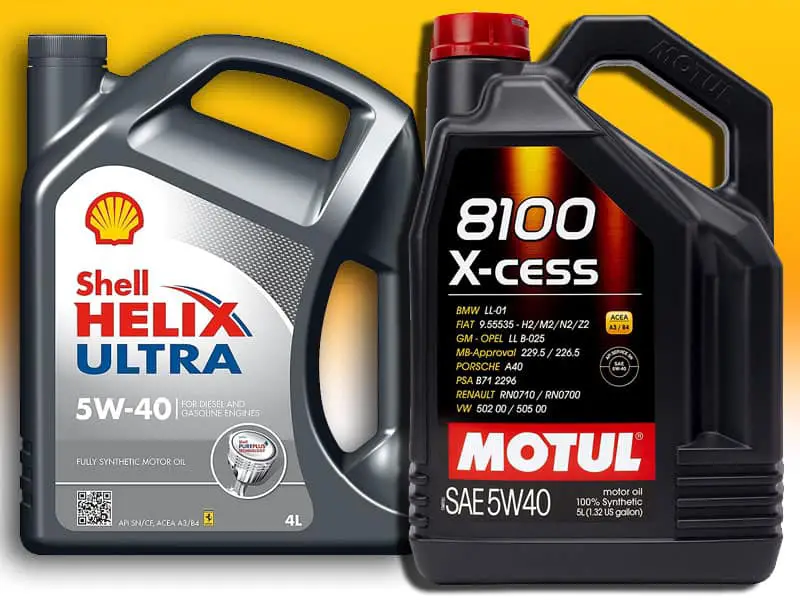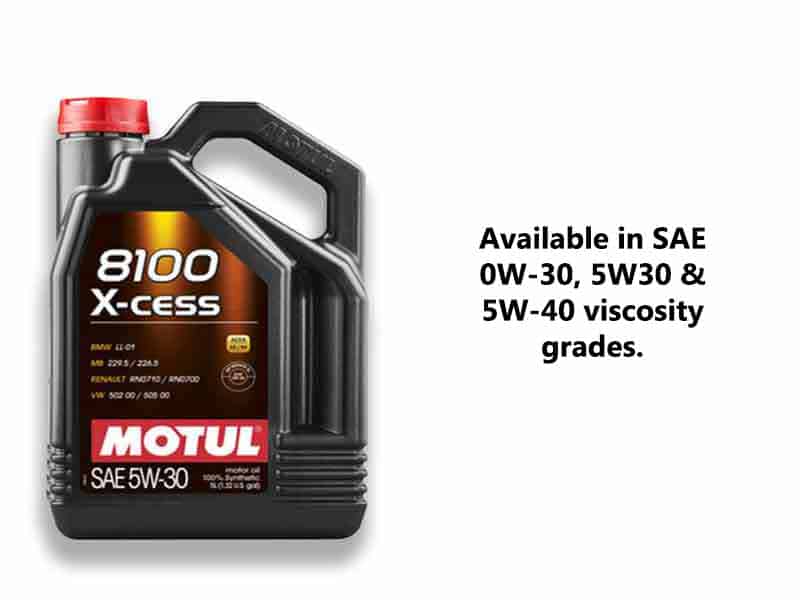Shell Helix Ultra is made up of group IV base oil and many additives to enhance its cleaning and anti-wear ability in severe conditions. Its ultimate cleansing technology is unparalleled to any engine oil. It provides approximately 1.5 to 2 % better fuel economy due to its low friction characteristic.
Besides being able to use in gasoline and diesel engines, Helix oil can also be used in gas, biodiesel and ethanol blend engines as well. Its ability to get started quickly in extremely cold weather is phenomenal.

It is approved & recommended by many well renowned car companies like Ferrari, BMW and Porsche.
Compare Shell Helix Ultra with others:
Comprised of group IV base oil and additives, Motul 8100 X-cess is known for being universal European engine oil.
Which means it is suitable for leaded or unleaded gasoline, biofuels, and it is compatible with catalytic convertor.
It is designed to meet the conditions of latest and powerful motor cars, usually it gets recommended for cars which are still under warranty. Its oil changing frequency is unmatched when compared to its competitor.
Approved and recommended by famous brands like BMW, Mercedes, FIAT, and General Motors.
Table of Contents
Shell Helix Ultra Vs Motul 8100
| Specifications | Shell Helix Ultra | Motul 8100 X-cess |
| Oil Type | Full Synthetic | Full Synthetic |
| Engine Type | Gasoline / Diesel / Gas / Biodiesel | Gasoline / Diesel, LPG, Biofuels |
| Available viscosity grades | SAE 0W – 30, SAE 0W – 40, SAE 5W – 20, 5W – 30, SAE 5W – 40, 10W-60 | SAE 0W-30, 5W – 30, SAE 5W – 40 |
| ILSAC | GF-5 | GF-5 |
| API | SN /CF | SN/CF |
| Oil change interval | 5,000 – 7,000 Km | 8,000 – 10,000 Km |
| Additives | Ultimate Cleaning Detergents, Anti-wear Additives, Rust and Corrosion Inhibitors | Anti-wear additives, Dispersants, Friction Modifiers, and Interior-cleansing Detergents |
| ACEA | A3/B3 , A3/B4 | A3/B4 |
Let’s start things with Viscosity:

Three major parameters are to be considered when comparing two engine oils. The first one is kinematic viscosity, an absolute viscosity of any liquid divided by its density at the same temperature. The viscosity of shell at higher and even at low temperature is lower than its contender.
Furthermore, Shell is available in more viscosity grades than Motul.
| Parameter | Shell (5W – 40) | Motul (5W – 40) |
| Kinematic Viscosity at 40o C | 79.10 cSt | 85.4 cSt |
| Kinematic Viscosity at 100o C | 13.10cSt | 14.2 cSt |
| Viscosity Index | 168 | 172 |
| Pour Point | – 45o C | -36o C |
Viscosity index is defined as the rate of change of viscosity per unit degree centigrade, means how much change in temperature affects the viscosity of any liquid. It is obvious from the table above that the viscosity index of Motul is higher than its challenger.

The last, but not least, parameter to consider is the pour point of any liquid. It is the minimum temperature below which any liquid loses its ability to flow. Shell has the lowest temperature than its competitor meaning it would not lose its flowing characteristic before its competitor.
Do Catalytic Convertor performs better With Them?
| Additive | Content in Shell (5W – 30) | Content in Motul (5W – 40) |
| Zinc | 780 ppm | 912 ppm |
| Phosphorous | 655 ppm | 807 ppm |
Zinc and phosphorous are present, in the form of zinc dialkyldithiophosphate (ZDDP), in both of the engine oils as an anti-wear additive. But in the combustion chamber, a small amount of it gets burn down and the formation of zinc and phosphorous ash occurs, which settles down on the catalytic convertor affecting its performance efficiency by blocking its passage.
So the engine oil with high content of zinc and phosphorus is going to create more ashes than its competitor, and hence affecting the engine performance more. It is obvious in the table above that Motul has far more quantity of zinc and phosphorous in it than Shell.
So in this regard, the best option would be to choose Shell for engine’s safety purpose.
Can they keep the engine clean?
| Additive | Content in Shell (5W – 30) | Content in Motul (5W – 40) |
| Magnesium | 11 ppm | 13 ppm |
| Sodium | – | 2 ppm |
| Calcium | 1651 ppm | 2235 ppm |
Whenever engine gets heated and the oil comes in contact with the oxygen molecules, a process known as oxidation occurs, which results in the formation of sludge and deposits.
So almost every engine oil is being added with magnesium, sodium and calcium as a cleansing detergent. So the engine oil which would have more quantity of these three additives would be considered with more cleaning ability than its competitor.
By analyzing the table above, it is clear that Motul is a better option when it comes to having a clean engine, since it contains all three additives more than Shell.
How they protect against fuel burning?
| Parameter | Shell (5W – 40) | Motul (5W – 40) |
| Flash Point | 242o C | 230 o C |
Whenever engine gets elevated to high temperature, an unavoidable situation occurs in which oil gets evaporated and burns off. It leads to the deficiency of engine oil’s quantity in the car and that could devastate the engine completely since there is not enough oil in it for smooth operation.
But which oil would vaporize quicker depends upon an important parameter known as the flash point. It is the minimum temperature at which the vapors of any liquid get burnt, if provided an ignition source.
So the engine oil with low flash point is more likely to get burn off earlier. It is obvious from the above table that Motul would burn off more quickly than Shell. So in this regard, Shell is a better and safer option than its competitor.
How they Minimizing Engine Wear-Off?
Over-heating, improper driving, neglecting regular maintenance or even carrying more weight could be the reason for engine wear-off. In short, it is bound to happen at some point.
And the only way to avoid it is by using engine oil having more anti-wear additive in it. One of the most popular anti-wear additive is zinc dialkyldithiophosphate known as ZDDP, a compound of zinc and phosphorous.
So an engine oil with high content of zinc and phosphorous would be more effective against engine wear-off. From the above introduced table, it is clear that Motul contains more anti-wear additives than Shell and hence it has the upper hand in this regard.
What is their Oil Change Frequency?
| Parameter | Shell (5W – 30) | Motul |
| Total Base Number | 5.85 mg KOH/g | 9.2 mg KOH/g |
During oxidation and even in the combustion process, many hazardous acids are being produced which could affect the performance of engine drastically and could potentially harm its operation.
That’s why engine oil manufacturers utilize alkaline additives into it to neutralize the acids which are formed as the by-product of essential reactions.
When an engine oil loses its ability to neutralize these acids, it is the point when one should change their engine oil. The ability of an engine oil to neutralize acids is measured by its Total Base Number (TBN).
The more TBN an oil has, the longer it is going to last in the engine. Hence, Motul is having more TBN than Shell which means it would last longer than its challenger and would have low oil change frequency.
Let’s conclude things:
Both of the engine oils are full synthetic engine oil, made up from the group IV base oil and many performance enhancing additives, designed to be used in latest and high power motor cars.
Shell is safer option in resilient environment since it does little harm to catalytic convertor and also does not burn-off quicker in high temperature conditions than its challenger.
But when it comes to cleansing and anti-wear ability, Motul is superior. But the major advantage Motul has is having less oil change frequency and hence surpassing Shell from economic point of view.
And the major advantage Shell has over its challenger is having less viscosity, viscosity index and pour point; which means its flowing characteristic and the tendency to not lose the lubricating characteristic both are phenomenal than its challenger.